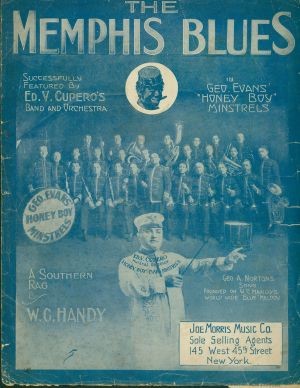
Early Forms That Influenced the Blues 3
From the recollections of the singer B. B. King, Ma Rainey (1886-1939), and the first composer of the blues, W.C. Handy (1873-1938), among others, it is evident that they had already heard the blues years before they became popular in the first few years of the twentieth century. Handy, affectionately known as the "Father of the Blues," composed "The Memphis Blues" (1912), his most famous piece, the "St. Louis Blues" (1914), "Beale Street Blues" (1916), and many other blues, which he published as sheet music. A selected list of W.C. Handy's compositions, arrangements, and books, is available here.

Life is like a trumpet. If you don't put anything into it, you don't get anything out of it.
W.C. Handy

In this, Oliver and Smith note that he was not alone, nor even the first. "The Dallas Blues" by Hart Wand and Lloyd Garrett (1912) and the now offensively titled "Nigger Blues" by Leroy "Lasses" White (1913) were a few among several blues compositions that in form and content may be traced back to the 1890s (Oliver 2012, n.p.).
| W.C. Handy at Age Nineteen | Memphis Blues Sheet Music Cover, 1913 | W.C. Handy in 1936 |
|---|---|---|
 |
 |
 |
| W. C. Handy, affectionately known as the “Father of the Blues,” was inducted into the Alabama Music Hall of Fame in 1987. | ||
An overview of W. C. Handy's life and contributions to blues is available below:

Father of the Blues, W. C. Handy Birthplace [ 00:00-00:00 ]

Mr. Handy's Blues: A Musical Documentary [ 00:00-00:00 ]
In addition, Alabama Black Belt Blues and the four-part general series on the Story of the Blues below dig deep into Alabama's Black Belt tradition of African American-inspired blues.

BLUES STORY: A Documentary
Then, listen to Handy's most famous blues composition, " St. Louis Blues" (1914), performed by Louis Armstrong and Bessie Smith.
Though it's impossible to pinpoint the exact musical influences that gave rise to the blues, most scholars agree early influences included African rhythms, field hollers, work songs, and spirituals, with a sound and lyrics that reflected the difficult lives of African Americans in post-Reconstruction America.





